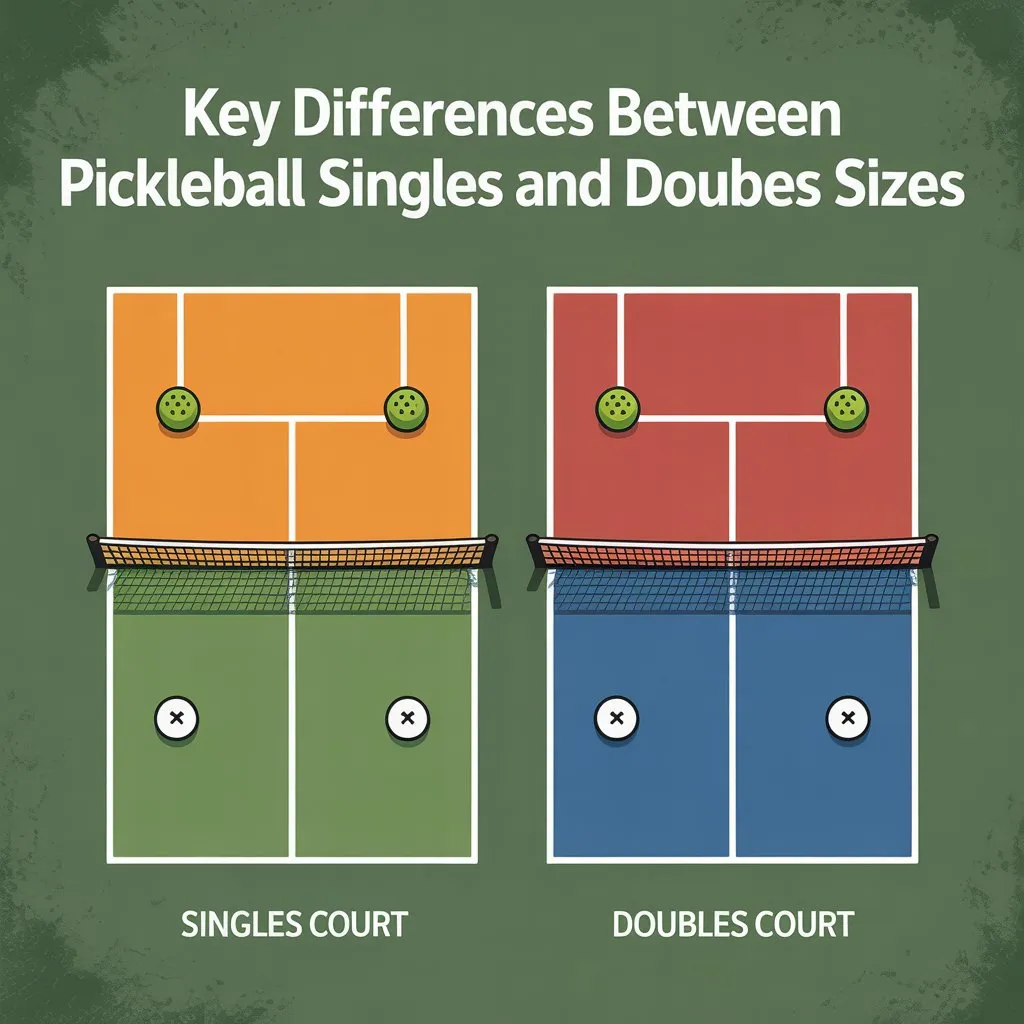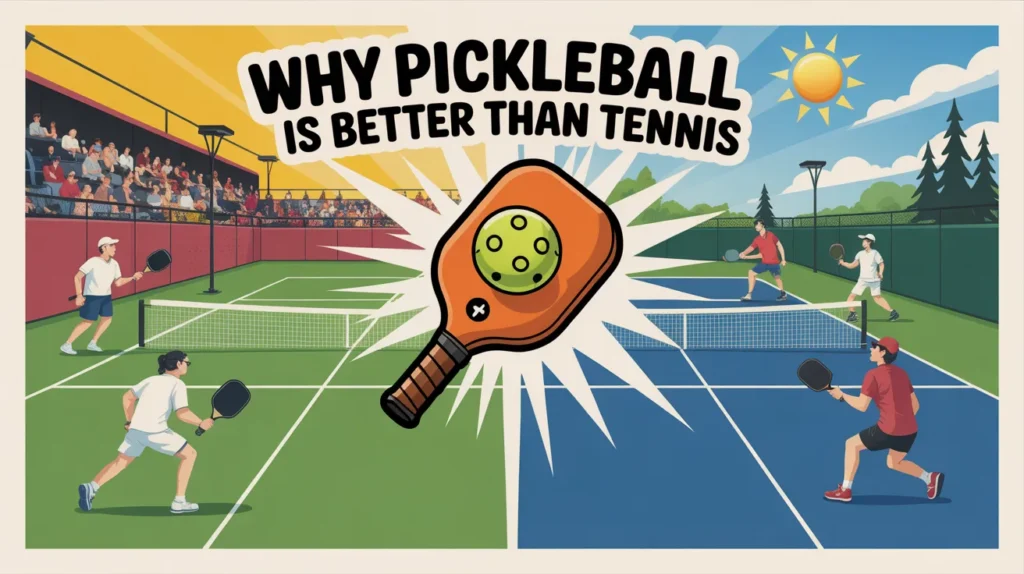The court size of pickleball differs for singles and doubles play. A singles court measures 20 feet wide by 44 feet long, while a doubles court is also 20 feet wide but 22 feet long. This extra length allows for more movement and strategy in doubles games. Understanding the court dimensions helps improve gameplay.
In this article, we will discuss the importance of these size variations and their impact on your game. Continue reading to elevate your pickleball skills.
What is Pickleball?
Pickleball is a fun, fast-growing sport similar to tennis but played with a paddle and a plastic ball. It’s easy to learn and can be enjoyed by people of all ages and skill levels, making it a popular choice worldwide.
Why Court Size Matters in Pickleball
Court size is essential because it affects movement, strategy, and gameplay. A larger court in doubles allows for more teamwork and defense, while a smaller singles court requires quicker footwork and more precise shots.
The Standard Pickleball Court Size
A standard pickleball court measures 20 feet in width and 44 feet in length. Both singles and doubles courts have the same width, but the doubles court is 22 feet long, offering more space for players to cover.
Dimensions of a Pickleball Court
The pickleball court is 20 feet wide and 44 feet long, with a 14-foot non-volley zone in the middle. This is the standard size for both singles and doubles play, ensuring a consistent playing experience for all.
Official Court Size Regulations
Official pickleball courts follow regulations set by the USA Pickleball Association (USAPA). The court should be 20 feet wide by 44 feet long, with specific markings for the serving area, net height, and non-volley zones.
Pickleball Singles Court Size – What You Need to Know
The singles court is 20 feet wide and 44 feet long, providing a smaller playing area than the doubles court. The narrower width impacts movement, requiring more agility and strategic shot placement to cover the court effectively.
How Singles Court Size Affects Gameplay
In singles, the court is narrower, which means players must move quickly and focus on precise shots. With less space to cover, singles play relies on speed, accuracy, and strong serving skills to gain an advantage.
Narrower court: In singles, the court is 20 feet wide, which means less space to cover.
Quick movement: Players must move quickly to cover the entire court by themselves.
Focus on precision: Accurate shot placement becomes crucial to outplay the opponent.
Speed and agility: Players must be fast and agile to respond effectively to every shot.
Strong serving: A powerful and accurate serve can give players a significant advantage in singles
Pickleball Doubles Court Size:
The doubles court is also 20 feet wide but is 22 feet long. This extra length provides more space for two players to cover, allowing for various strategies such as teamwork and coordinated movements, which makes the game dynamic.
How Doubles Court Size Impacts Gameplay
In doubles, the additional length gives players more room to move and position themselves. This extra space enables better teamwork and defensive plays, allowing players to work together more effectively to cover the court more efficiently.
Court Coverage: Doubles play requires covering more space, leading to faster exchanges.
Teamwork: More coordination and effective communication between teammates are essential.
Positioning: Strategic positioning is crucial, as players must cover various areas of the court.
Speed of Play: The pace is generally faster due to the larger court and the involvement of multiple players.
Tactics: Emphasizes teamwork, positioning, and quick reactions rather than individual skills.

Key Differences Between Pickleball Singles and Doubles Court Sizes:
| Key Differences | Pickleball Singles Court | Pickleball Doubles Court |
| Court Width | 20 feet | 22 feet |
| Court Width | 20 feet | 22 feet |
| Space for Movement and Strategy | Less room for movement and strategy. | More room for players to move and strategize. |
Width vs Length – What is the Real Impact?
The width of the court remains the same for both singles and doubles, but the length changes. The longer doubles court allows for more movement and strategic plays, while singles play requires faster, more accurate shots in a tighter space.
Movement and Strategy Variations:
Singles play requires fast movement and precise shots, while doubles allows players to cover more ground together. In doubles, communication and teamwork are key to managing the larger court area and executing well-timed plays.
Which is Easier: Singles or Doubles?
Doubles can be easier for some players as the court is shared between two people, offering more space and less pressure on each player. Singles requires quicker footwork and more personal responsibility for covering the entire court.
How to Adapt Your Game to Singles Court Size:
In singles, focus on quick footwork and accurate shot placement. Use the court’s narrower width to your advantage by targeting areas your opponent might struggle to reach, and always be prepared to cover the entire court on your own.
How to Adapt Your Game to Doubles Court Size:
In doubles, teamwork is essential. Communicate with your partner, cover different areas of the court, and use the extra space to set up strategic shots. Move together to avoid leaving open spaces for your opponents to exploit.
Impact on Beginner vs Advanced Players:
Beginners may find singles challenging due to the smaller court size and the need for quick reflexes. In contrast, advanced players excel in both formats, utilizing strategy, teamwork, and swift decision-making to capitalize on the court space.
Court Size and Game Pace:
A singles court can lead to faster-paced games due to the smaller playing area, while doubles allows for more extended rallies and strategic plays due to the added length. Both formats challenge players, but at different paces.
Modifying Court Size for Different Needs:
While standard courts are used in official matches, players in casual settings can adjust the size of the court to suit their needs. Reducing court size for beginners or for practice sessions is a great way to build skills before moving to full-size courts.
Temporary Court Setups for Singles and Doubles:
Temporary courts for both singles and doubles can be set up in various locations using portable net systems. Whether for a casual game or practice, modifying the court size can provide flexibility without sacrificing gameplay quality.
Conclusion:
Whether you are new to pickleball or a seasoned player, understanding the differences between singles and doubles court sizes can significantly enhance your strategy and performance. The singles court demands speed and precision, challenging players to master footwork and shot placement, while the doubles court emphasizes teamwork and strategic positioning. Adapting to the different court sizes, understanding their impact on gameplay, and refining your tactics accordingly will help you elevate your skills in both formats. The beauty of pickleball lies in its versatility, allowing players of all levels to enjoy the game at their own pace while developing their skills.
FAQ:
What are the differences between the singles and doubles pickleball court sizes?
The key difference between the singles and doubles pickleball court sizes is the length. While both courts have the same width (20 feet), the singles court is 44 feet long, while the doubles court is 22 feet longer, measuring 66 feet in length. This extra length in the doubles court allows for more movement and strategic plays, creating a distinct dynamic in the game.
How does the court size impact the pace and style of play in pickleball?
Court size significantly impacts the pace and style of play. In singles, the smaller court size leads to faster play due to the quicker movement and precise shot placement required. In doubles, the larger court size leads to more extended rallies and team-based strategies, with a greater emphasis on coordination, communication, and positioning.
What are the key strategies for playing on a singles court?
In singles, the narrow court demands quicker reflexes and precise shot placement. Players need to move quickly to cover the entire court and focus on the strategic placement of shots to force errors from their opponent. Strong serving is also a critical aspect of singles play.
How should you adapt your strategy to the larger doubles court?
In doubles, focus on teamwork and communication. Coordinate with your partner to cover different areas of the court and move together to avoid leaving open spaces. Take advantage of the extra length to set up more strategic plays and execute well-timed shots as a team.
Which format is easier, singles or doubles?
Many players find doubles easier because the court is shared between two people, offering more space and less pressure on individual performance. Singles can be more challenging due to the need to cover the entire court alone, requiring quicker footwork and greater stamina.
Can the court size be modified for different skill levels or practice?
Yes, the court size can be adjusted for beginners or practice sessions. Reducing the court size allows players to build skills in a less demanding environment. Temporary court setups can also be used for both singles and doubles, giving players the flexibility to practice without compromising on gameplay quality.
Also Read:


